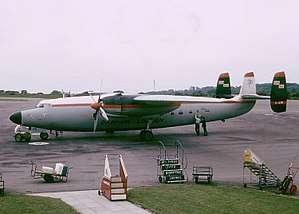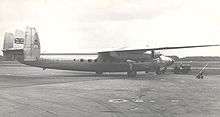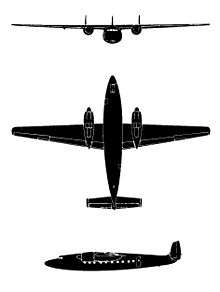Airspeed Ambassador
The Airspeed AS.57 Ambassador is a British twin piston-engined airliner that first flew on 10 July 1947 and served in small numbers through the 1950s and 1960s. The planes are sometimes referred to as "Elizabethans", as they were originally ordered and popularised by British European Airways as the planes used for their "Elizabethan Class" passenger service.
| AS.57 Ambassador | |
|---|---|
 | |
| Dan Air Ambassador at Bristol Airport in 1965 | |
| Role | Airliner |
| Manufacturer | Airspeed Ltd |
| First flight | 10 July 1947 |
| Introduction | 1951 |
| Primary user | British European Airways |
| Produced | 1947–1953 |
| Number built | 23 |
Design and development
The Ambassador had its origin in 1943 as a requirement identified by the Brabazon Committee for a twin-engined short-to-medium-haul replacement[1] for the Douglas DC-3. Airspeed Ltd. was asked to prepare an unpressurised design in the 14.5-ton gross weight class, using two Bristol Hercules radial engines. In 1943, the company duly set up a dispersed design office in Fairmile Manor at Cobham in Surrey.
By the time the British Ministry of Aircraft Production ordered two prototypes from Airspeed, immediately after the end of the Second World War, the design had grown substantially. The Ambassador would be pressurised, have more powerful Bristol Centaurus radials and have a maximum gross weight of almost 24 tons.[1]
The revised design offered seating for 47 passengers and, having a tricycle undercarriage, looked more modern than the DC-3s, Curtiss Commandos, Avro Lancastrians and Vickers Vikings that were common on Europe's shorter airline routes. With three low tailfins and a long pointed nose, it shared something of the character of the larger transcontinental Lockheed Constellation.
Great efforts were made to reduce drag, to improve performance and cruising efficiency. A NACA laminar-flow wing section was chosen to reduce drag although structural features for wing construction, propeller slipstream over the inner wing and increasing skin roughness with service were some of the things which reduced the optimistic NACA section performance measured in a wind-tunnel. The engine nacelles were first designed with inwardly opening louvres for exhaust gases and cooling air rather than the usual outwardly opening "gills". However, these proved inadequate to cool the engine, so the gills were reinstated. Engine-out climb performance was enhanced by being able to feather the propeller using a zero-torque signal from the engine.[2]
Three prototypes were built, the first registered G-AGUA was first flown by George B.S. Errington from Christchurch on 10 July 1947.[3] The second Ambassador, G-AKRD,[4] was used by the Bristol Aeroplane Company from 1953 for flight-testing the Bristol Proteus 705 turbine engine. From March 1958 it was used by Rolls-Royce for test flying the Dart and Tyne turboprops.[1] The third prototype and first Ambassador 2 G-ALFR was used for BEA proving trials[4] and from 1955 in the development trials of the Napier Eland turbine engine. Intensive simulated airline flying, to pave the way for BEA Vanguards, was done in 1958 with two Tyne-powered Ambassadors.[5]
Operational history
British European Airways (BEA) placed a £3 million order for 20 aircraft in September 1948, and operated them between 1952 and 1958, calling them their "Elizabethan Class" in honour of the newly crowned Queen.[3] The flagship of the fleet was G-ALZN, appropriately named "RMA Elizabethan". The first "Elizabethan" scheduled flight was from Heathrow to Paris Le Bourget on 13 March 1952 and the type later also served the key UK routes. By December 1955 the "Elizabethan Class" had reached 2,230 flying hours annually, per aircraft, the highest in BEA's fleet. However, the last Elizabethan scheduled service for BEA was operated in August 1958, and the type was replaced by the Vickers Viscount.
Further sales were not achieved, largely due to the attitude of de Havilland staff at Hatfield following the take-over of Airspeed in 1951. They preferred to use Airspeed's factory at Christchurch to produce military jets designed by de Havilland;[6] the Sales Director was recalled to Hatfield from Australia when Trans-Australia Airlines were on the point of placing an order for 12 Ambassadors.[7]

After disposal by BEA, the type helped to establish the scheduled and charter flight operations of Dan-Air, an important airline in the development of package holidays. The type was also used in the UK by Autair and BKS Air Transport. Second-hand Ambassadors were flown for short periods by Butler Air Transport (Australia), Globe Air (Switzerland) and Norrønafly (Norway).[8]
The popularity of this aircraft, with its pressurised cabin and good soundproofing, was soon eclipsed by the arrival of turboprop-powered aircraft such as the Vickers Viscount and, some years later, the Lockheed Electra, which featured more reliable engines and faster speeds. The coming of turboprops and the dawning of the Jet Age caused the Ambassador to fall out of favour.
Variants

- AS.57 Ambassador 1
- Prototype aircraft with Bristol Centaurus 130 engines, two built.[9]
- AS.57 Ambassador 2
- Production version with Bristol Centaurus 661 engines, 21 built including the production prototype.[10]
Projects
- AS.59 Ambassador II
- Project for either a twin-engined variant with Bristol Proteus or Bristol Theseus engines or a four-engined variant with Napier Naiads or Rolls-Royce Darts.[11] From the first prototypes, the Ambassador's wing had been stressed for four Naiad turboprops, but no four-engined variant flew.[12]
- AS.60 Ayrshire C.1
- Proposed variant to meet Air Ministry Specification C.13/45 for a medium-range military transport with a rear-fuselage loading ramp.[11] Ten were ordered in October 1946 but were not built, after a review of the design's projected performance produced figures lower than the Air Ministry's requirements.[13]
- AS.64
- Proposed military transport variant for the Royal Air Force to meet Air Ministry Specification C.26/43, not built.[11]
- AS.66
- Proposed civil freighter variant.[11]
- AS.67
- Proposed civil freighter variant.[11]
Accidents and incidents
- 8 April 1955: G-AMAB, Sir Francis Bacon of British European Airways was damaged beyond repair in a forced landing south-west of Düsseldorf, Germany.[14][15] This aircraft had often been used by the Queen and Prince Philip when travelling to Europe in the early 1950s.[16]
- 6 February 1958: G-ALZU, Lord Burghley, also of BEA, in what became known as the Munich air disaster, crashed on takeoff after a refuelling stop at Munich while operating a charter flight from Belgrade, Yugoslavia, to Manchester, England. This crash received tremendous public attention in the UK as it involved team members and staff of Manchester United Football Club, together with representatives of the national press. 23 of the 44 people on the plane died as a result of their injuries in the crash, including eight Manchester United players.[17] The investigation eventually focussed on runway slush adversely affecting the speed of the plane as it attempted to take off.
- 14 April 1966: G-ALZX of Dan-Air was damaged beyond repair when landing at Beauvais, France.[18]
- 14 September 1967 G-ALZS of Autair was damaged beyond repair when landing at Luton Airport, UK. The aircraft overran the runway and ended up in soft clay.[19]
- 3 July 1968: G-AMAD of BKS Air Transport crashed at London Heathrow Airport. All but two of its crew as well as several horses which were being transported and their grooms, were killed. A parked Trident airliner was damaged beyond repair (G-ARPT) and another Trident had its tail torn off before the airliner hit terminal buildings and came to rest. The accident was found to have been caused by the failure of a flap actuating rod in the Ambassador's port (left) wing. Coincidentally, the Trident which suffered the damaged tail (G-ARPI) was subsequently repaired and later involved in an (unconnected) fatal accident in June 1972.[20]
- 30 September 1968: G-AMAG of Dan-Air was damaged beyond repair in a wheels-up landing at Manston, United Kingdom.[14][21]
Operators
Civil operators
- Butler Air Transport - operated three different aircraft[22]
- Norrønafly - proposed to operate two aircraft but they never entered service.
- South Seas Airways - bought one aircraft but failed to gain an operators licence and it was never delivered to New Zealand.
- Globe Air - operated three different aircraft[22]

- Autair International Airways - operated three different aircraft
- BKS Air Transport - operated three different aircraft[22]
- British European Airways - operated 20 different aircraft
- Dan-Air - operated seven different aircraft
- Decca Navigator Company - one aircraft
- Napier
- Rolls-Royce
- Shell Aviation Limited - two aircraft[22]
Military operators
- Royal Jordanian Air Force operated three former British European Airways aircraft, first one delivered in 1959.[22]
- Moroccan Royal Flight
Aircraft on display
.jpg)
One Elizabethan, Christopher Marlowe (G-ALZO, c/n 5226), survives and is under long term major restoration by the Duxford Aviation Society at the Imperial War Museum, Duxford near Cambridge.
Specifications

Data from Airspeed aircraft since 1931,[23] British Civil Aircraft since 1919 Volume 1[24]
General characteristics
- Crew: 3
- Capacity: Up to 60 passengers
- Length: 81 ft (25 m)
- Wingspan: 115 ft (35 m)
- Height: 18 ft 4 in (5.59 m)
- Wing area: 1,200 sq ft (110 m2)
- Aspect ratio: 11:1
- Empty weight: 35,884 lb (16,277 kg)
- Max takeoff weight: 52,000 lb (23,587 kg)
- Fuel capacity: 1,000 imp gal (1,200 US gal; 4,500 l) in two integral wing tanks, with provision for 600 imp gal (720 US gal; 2,700 l) in two centre-section bag tanks
- Powerplant: 2 × Bristol Centaurus 661 18-cylinder air-cooled sleeve-valve piston enigines, 2,625 hp (1,957 kW) each
Performance
- Maximum speed: 312 mph (502 km/h, 271 kn) at 75% power with 11,650 lb (5,280 kg) payload
- Cruise speed: 300 mph (480 km/h, 260 kn) at 20,000 ft (6,100 m) at 50,000 lb (23,000 kg)
- 279 mph (242 kn; 449 km/h) at 60% power
- Range: 720 mi (1,160 km, 630 nmi) with 11,650 lb (5,280 kg) payload and no reserves at 280 mph (240 kn; 450 km/h)
- 900 mi (780 nmi; 1,400 km) at 220 mph (190 kn; 350 km/h)
- 1,560 mi (1,360 nmi; 2,510 km) with 7,900 lb (3,600 kg) payload max. fuel at 280 mph (240 kn; 450 km/h)
- 1,950 mi (1,690 nmi; 3,140 km) with 7,900 lb (3,600 kg) payload max. fuel at 220 mph (190 kn; 350 km/h)
- Rate of climb: 1,520 ft/min (7.7 m/s) at 5,000 ft (1,500 m) at maximum weight
- Rate of climb on one engine: 420 ft/min (130 m/min) after take-off at maximum weight
- 360 ft/min (110 m/min) at 5,000 ft (1,500 m) at maximum weight
- Wing loading: 43.3 lb/sq ft (211 kg/m2) at 52,000 lb (24,000 kg)
- Power/mass: 0.1 hp/lb (0.16 kW/kg) at 52,000 lb (24,000 kg)
- Take-off distance to 50 ft (15 m): 3,270 ft (1,000 m) at maximum T.O weight
- Take-off distance to 50 ft (15 m) one engine: 4,950 ft (1,510 m) at maximum T.O weight
- Landing distance from 50 ft (15 m): 2,565 ft (782 m) at max landing weight
See also
Aircraft of comparable role, configuration and era
Related lists
References
- Notes
- Phipp 2007, pp. 75-77.
- Boot, pp.25-26.
- Singfield 2000, p. 12.
- Jackson 1973, p. 30.
- Rolls-Royce Aero Engines, Bill Gunston 1989, Patrick Stephens Limited, ISBN 1-85260-037-3, p.128
- Masefield and Gunston, p.83
- Masefield and Gunston, p.214
- Jackson 1973, pp. 395–396.
- Jackson 1973, p. 25.
- Jackson 1973, p. 26.
- "Airspeed Type Designations." Flight International, 23 February 1951, p. 228.
- Boot, p.25
- Boot, p.24
- Eastwood and Roach 1991, p. 7.
- "Accident description: Airspeed AS.57 Ambassador 2, 8 April 1955." Aviation-safety.net. Retrieved: 13 November 2010.
- Eastwood and Roach 1991, p.12.
- "Accident description: Airspeed AS.57 Ambassador 2, 6 February 1958." Aviation-safety.net. Retrieved: 6 May 2012.
- https://aviation-safety.net/database/record.php?id=19660414-1
- https://aviation-safety.net/database/record.php?id=19670914-0
- "Accident description: Airspeed AS.57 Ambassador 2, 3 July 1968." Aviation-safety.net. Retrieved: 6 May 2012.
- "Accident description: Airspeed AS.57 Ambassador 2, 30 September 1968."Aviation-safety.net. Retrieved: 13 November 2010.
- "Airspeed AS.57 Ambassador". British aviation projects to productions. Retrieved 8 May 2020.
- Taylor, H.A. (1970). Airspeed aircraft since 1931. London: Putnam. pp. 110–134. ISBN 0370001109.
- Jackson 1973, p. 29
- Bibliography
- Boot, Roy (1990). From Spitfire to Eurofighter: 45 years of Combat Aircraft Design. Shrewsbury, UK: AirLife Publishing. ISBN 1-85310-093-5.
- Eastwood, Tony; Roach, John (1991). Piston Engine Airliner Production List. West Drayton, UK: The Aviation Hobby Shop. ISBN 0-907178-37-5..
- Jackson, A.J (1987) [1973]. British Civil Aircraft since 1919 Volume 1. London: Putnam. ISBN 0-85177-808-9..
- James, Derek (April 2003). Database: Airspeed Ambassador. Aeroplane Monthly. 31.
- Masefield, Sir Peter; Gunston, Bill (2002). Flight Path. Shrewsbury, England: Airlife. ISBN 978 1 8403 7283 0.
- Phipp, M (2007). The Brabazon Committee And British Airliners 1945-1960. Stroud: Tempus. ISBN 978 0 7524 4374 4.
- Singfield, Tom (2000). Classic Airliners. Leicester, UK: Midland Publishing. ISBN 1-85780-098-2..
- Taylor, H. A (1970). Airspeed Aircraft since 1931. London: Putnam. ISBN 0370001109.
External links
| Wikimedia Commons has media related to Airspeed AS.57 Ambassador. |